Polycarbonate Information Page
| Polycarbonate Information Page Updated 07/30/2007 Why Polycarbonate?
|
 Will it Break? No! |
| Laser-cut Lexan properties The cut edge has a black residue which can easily be cleaned with a damp rag or paper towel. It is normal and can't be helped. When the residue is cleaned off, the edge will still be darker than the material. The dark edge is going to be present no matter what color the Lexan is. Most people like the way the cut edge looks, but there are some who would prefer not to have the dark edge. Technically, it would be possible to try to polish the edges, but beware it would be a very labor intensive project, and not worth the trouble in my opinion. |
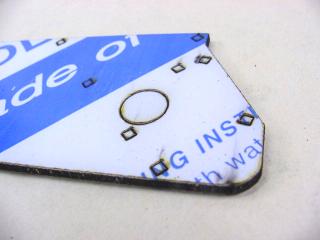 Figure 1. |
| Lexan protective covering The Lexan pieces have a protective covering that needs to be removed before assembly. When the laser cuts, the covering melts into the cut edge which can make removal difficult. If you gently scrape the cut edge with a metal edge, such as a flat blade screw driver, the covering can easily be separated with a thumb nail. |
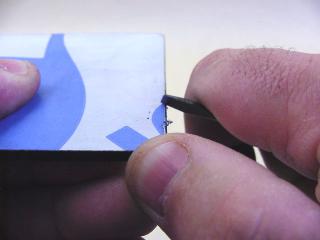 Figure 2. |
| Peal and Separate Once it is started the covering easily peels off of the pieces. Note, you only want to scrape the edge. If done properly the pieces will not be damaged at all.
|
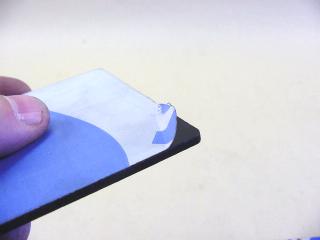 Figure 3. |
| Stubborn Coverings From time to time the coverings can be more difficult to remove. If you have trouble you can gently scrape the cut edge as explained above, then put a piece of Duct Tape over it, then rip it up. This really works pretty well. |
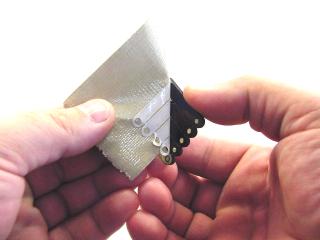 Figure 4. |
| The Finish Lexan has a beautiful mirror smooth finish. However, in time it will get tiny surface scratches due to cleaning and normal wear and tear. It isn't really that noticeable, but under the right conditions it can be visible. Note: this step is optional! There are some options for modifying the finish. The Lexan parts can be sand blasted with a fine medium. I especially like the look on the black components. The parts can be lightly sanded by hand, or with a random orbit sander with extra fine sand paper. This is easy to do, but should be done carefully to avoid removing too much material. The key is to make light even passes with the sander. The result is a durable charcoal gray appearance that can't be scratched, because it has been pre-scratched in
every direction. |
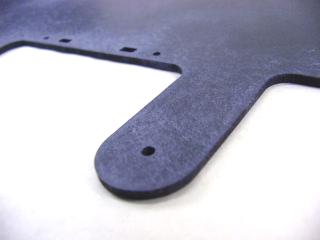 Figure 5. |
| Here is an image of our old Pan and Tilt with the random orbit finish. |
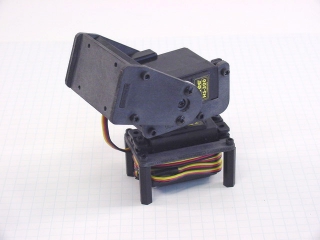 Figure 6. |
| Finishing the holes The holes in the panels just need a bit of a push and they just fall out. I am using a 3/32" ball end hex driver here. It works quite well and it's required to build the kits anyway. |
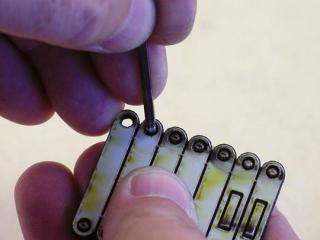 Figure 7. |
| Separating the parts Some of the kits have parts nested to simplify packaging and reduce errors. Larger parts can be snapped apart. The smaller parts can be easily separated with a hobby knife. Be careful! Use a large wood backer and work slowly. |
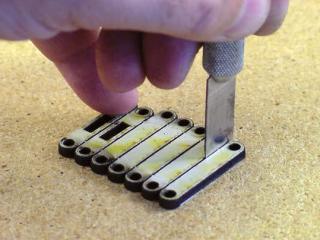 Figure 8. |
| Separating the optional openings Some of the kits have optional openings that need to be cut out before assembly. Carefully press a flat Exacto knife into the opening where the part is attached to the main panel. Caution! Do not attempt to snap these optional openings apart. |
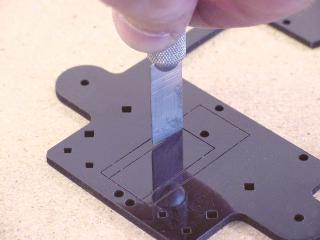 Figure 9. |
| Caution! Lexan is the same material used in bullet proof glass. It is very strong, but has one important weakness. In the presence of certain chemicals, it will "craze". This means it will crystallize, become brittle, and even shatter. One substance in particular to watch out for is 1, 1, 1 Trichloroethane. This is a solvent, present in some motor cleaners and degreasers, which will crystallize polycarbonate on contact. Trichloroethane is a liquid CFC and has been removed from use, but may still be out there. Some products have switched to its cousin, 1, 1, Difluoroethane. While not as vigorously reactive as the previous chemical, it is still capable of crazing Lexan if allowed to come into contact for too long. Also avoid using Loctite or thread locks on the chassis assembly. They are not necessary and may cause damage to the Lexan. |
|
| Other Information Lexan is a bit on the expensive side compared to foam PVC and acrylic, but the added strength makes it well worth the added cost. It can be drilled and cut easily using standard wood working tools. Use a low speed on the tool and low feed rates to prevent the plastic from melting to the tool. Have fun building your robots, and above all be careful! |

